Web push notifications: The key to boosting engagement
By Sean Tinney July 2, 2024
There are over 1 billion websites on the world wide web.
Did your jaw just hit the floor?
That’s a staggering amount of competition for web traffic.
Driving web traffic is hard enough. But when you consider returning website visitors converted more than 73% more than first time visitors, it can feel even more overwhelming.
How on earth can you convince people to visit your website twice?
The secret is with web push notifications.
Want to make web push notifications a part of your marketing strategy? Read on to learn how to create push notifications that make it easy to drive traffic back to your website and make more sales.
Moreover, combining email marketing with web push notifications creates a powerful, multi-channel campaign that boosts engagement and revenue.
What are web push notifications?
Imagine having a tool that sends friendly nudges directly to your visitors’ desktops or laptops. These are web push notifications—short, clickable messages that pop up when your visitors have their browser open, even if they’re not currently on your website.
Once someone opts in, they don’t need to be on your site to get these notifications. You’ve probably seen these notifications yourself; they’re those small notices asking if you want to stay updated with new content or offers from a site you visited.
They typically show up in the corner of the screen and act as alerts for exclusive deals, offers, promotions, or freebies. The goal is simple: to bring your audience back to your website or landing page and encourage them to take action.
Here’s an example of an opt-in message:

Once they opt-in, they’ll begin receiving web push notifications. Here’s what they’ll look like when someone is online.

Benefits of web push notifications
1. Easy to opt-in
Opting in is super simple—just the click of a button. When visitors click “allow,” they’ll start getting your notifications right away.
2. Instant communication
We all know promoting content can be tough with so many platforms and competitors out there. Web push notifications cut through the noise, instantly showing up directly on your subscribers’ browsers.
3. Owned communication channel
Unlike social media, where algorithms decide who sees your posts, you own your web push notifications audience. You reach 100% of your opted-in subscribers directly. It’s your audience, your rules.
4. Drive traffic without advertising costs
Want to drive traffic back to your site without spending money on ads? Web push notifications are the answer. You can let your subscribers know about limited-time sales or exclusive offers for much less than paid ads.
5. Build deeper connections
Web push notifications empower you to treat your subscribers like VIPs by sending them exclusive content and updates. Building these deeper connections can turn casual website visitors into loyal brand advocates.
6. Grow your email list
You can use your existing email subscribers to grow your web push notification list and vice versa. By driving traffic to your sign-up pages, you can increase both your email and notification subscribers, creating a multi-channel communication network.
7. Complement your email marketing
Web push notifications are a great complement to any email marketing campaign. They don’t replace emails but, instead, complement them. With this multi-channel approach, you get more touchpoints to connect with your audience, making your strategy even stronger.
8. Save time
Creating web push notifications is quick and easy. These tight little messages take less time to make than other marketing techniques, which allows you to effectively communicate more quickly.
9. Communicate limited-time offers instantly
Keep your subscribers in the loop about limited-time offers as soon as they launch. This instant communication ensures they don’t miss out on great opportunities, keeping them engaged and, moreover, happy and appreciative of the deal you gave them.
Real-world examples of web push notifications
Motivate customers with daily tips
Donna Partow, a content creator and motivational speaker, uses web push notifications to deliver daily reminders and content for her challenges.
“I’m really excited about using web push notifications for limited-time challenges. Each day, I send a reminder with a link to keep them moving forward on their goal. My audience appreciates receiving these notifications because they are beneficial.”
– Donna Partow
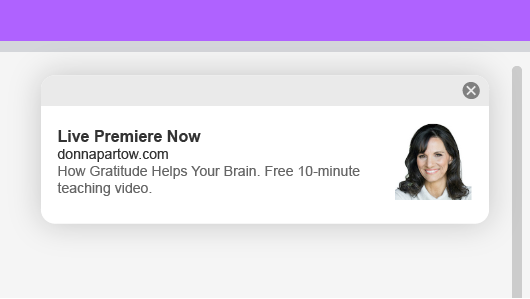
Notify followers instantly when you create new content
Jennifer Reinhard, a cloth diaper educator, uses web push notifications to share new and evergreen content with her audience. This method ensures her educational material reaches readers exactly when they need it.
“Web push notifications are another method to reach my readers. They may not read the email or see Facebook posts, but they will see the web push notification because it pops up on their desktop when they’re online — exactly when they need it.”
– Jennifer Reinhard
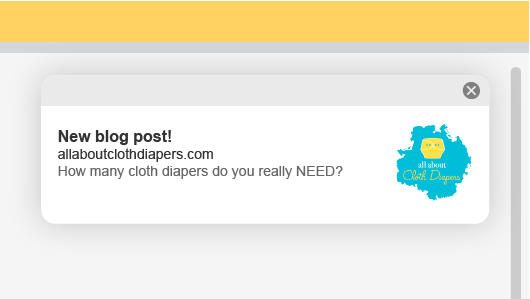
Drive traffic to specific articles
Jamila Bannister, a personal branding strategist, uses web push notifications to drive traffic to her online magazine and specific articles. This helps maintain a steady flow of readers to her content.
“I use web push notifications to drive traffic back to my online magazine and specific articles. This keeps my audience engaged with my most up-to-date content.”
– Jamila Bannister

Increase sales with limited-time offers
John Grubb, owner of Keystone Computer Concepts, uses web push notifications to send time-sensitive security alerts and special offers. This strategy helps him maintain customer engagement without overwhelming them with emails.
“Web push notifications are really important because I can send out time-sensitive offers without additional emails. This keeps my customers informed and engaged.”
– John Grubb

Components of a web push notification
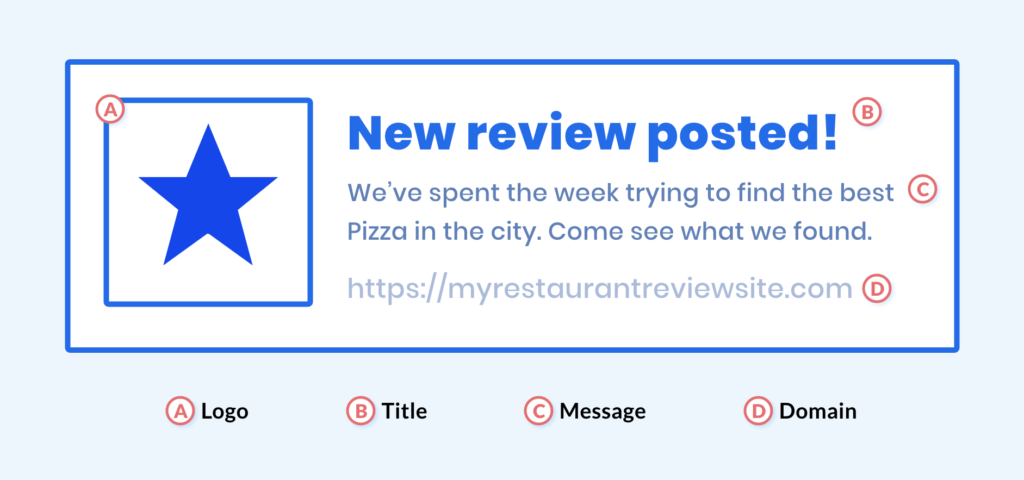
A: Logo
Including a brand logo or image on a web push notification provides instant recognition from a user. It’s a highly visual way for a subscriber to recognize that the message is coming from your brand and can drive them to read the notification and take action.
B: Title
The title of the web push notification is also called the header text. This is the piece of text that will catch the attention of a subscriber and encourage them to read on.
C: Message
This vital section is where you can elaborate on your message. This is your opportunity to concisely explain the value a subscriber receives from clicking on your push notification and visiting your site. Answer questions like: what will your subscribers receive by visiting your site? How long will the offer last?
Keep in mind, however, that web push notifications are meant to be short and sweet. Avoid jargon and use simple and direct language.
D: Domain
This is the URL that the user subscribed to. Including the source link in your message can’t be changed. It not only serves to remind the subscriber of your website, but aids in recognition and awareness of your online presence.
Best practices for web push notifications
Follow the best practices below to create web push notifications your audience will no doubt appreciate.
1 – Copy is king
The content of your web push notifications should be compelling and concise. Every word counts when you’re dealing with restrictive character limits, so make sure your message is clear and impactful.
2 – One topic per push
It’s best to stick to just one message per notification. Clear and focused messages end up with higher click-through rates, so don’t dilute your messages by pushing two things at once.
3 – Create urgency
Being specific about time sensitivity and urgency is a great way to drive action. Instead of saying “Flash Sale Today,” try “Only a few hours left to save 25%.” This very specific urgency encourages clicks right now.
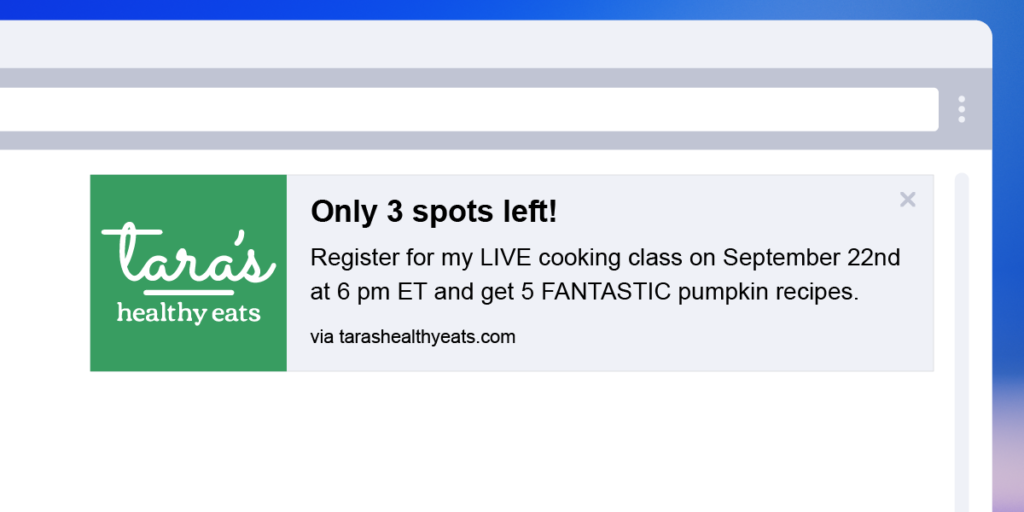
4 – Include social proof
You should include testimonials, reviews, and social proof to gain the trust of your audience. Pointing things out like “500 people have already registered today” or “This post has over 10,000 shares” reassures subscribers of your legitimacy and encourages them to act.
5 – Value first
Always provide value before asking for anything in return. Wouldn’t you want that when you’re buying from a brand? By offering value first, your audience is more likely to engage with and trust you.
6 – Use power words
Power words like “now,” “you,” “new,” and “free” can evoke emotion and drive action. These types of words make your notifications more compelling, urgent, and clickable. We put together 8 power words for you to use in your emails, but they also have an impact on any marketing copy you write.
7 – Create a sense of FOMO
Fear of Missing Out (FOMO) is a powerful motivator. Use it to create urgency and drive clicks. Limited-time offers or exclusive deals make subscribers more likely to act quickly.
8 – Exclusivity
Make your subscribers feel special with exclusive deals and promotions. Try highlighting the benefits of being part of a members-only program to boost their sense of belonging and value.
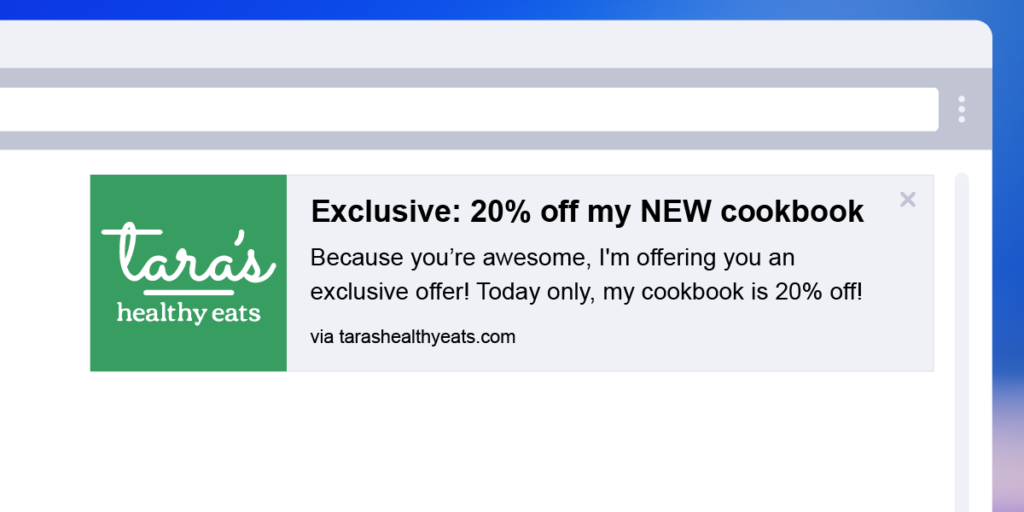
9 – Keep it short & sweet
Web push notifications have strict character limits. Aim for around 120 characters for the message, 50 for the title, 15 for the call to action, and one image. Communicate your message effectively within these constraints.
10 – Use emotion
Incorporate emotion into your notifications through humor, empathy, and references to trends or pop culture. Ensure your references are understandable and align with your brand voice. Genuine emotion resonates best when it serves your audience.
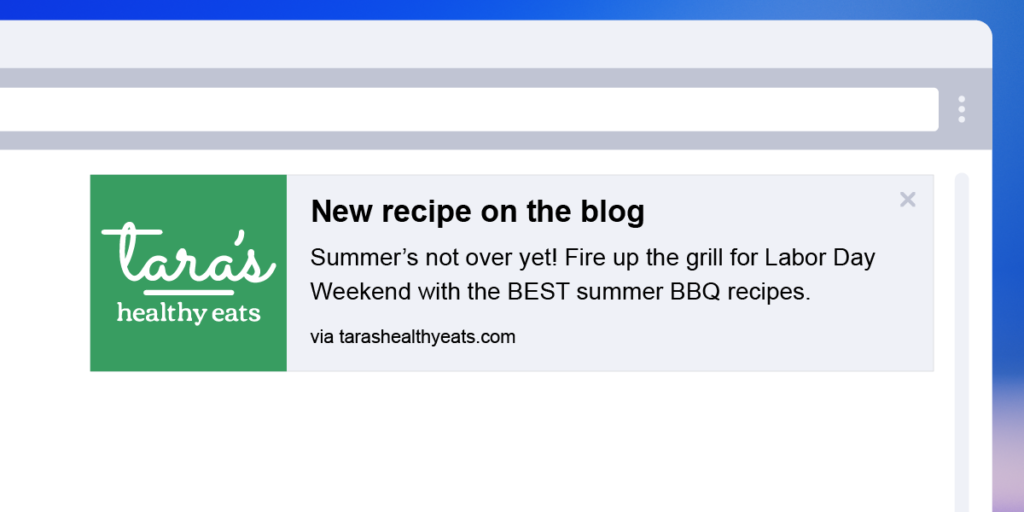
Get web push notifications
If you’re finding it challenging to reach more people and keep them engaged, web push notifications might be the solution you’ve been looking for. This powerful tool allows you to send direct messages straight to your visitors’ browsers, helping you expand your online reach and connect with your audience in real-time.
With just a simple click, your visitors can opt-in to receive notifications, ensuring they stay updated with your latest content, offers, and announcements.
And the best part? AWeber’s web push notifications are included at no additional cost with AWeber Free, AWeber Lite, and Plus plans. This means you can start with this powerful tool without any extra cost, making it easier than ever to boost your marketing strategy and achieve your business goals.Start using web push notifications today and experience the difference they can make.
Sign up for AWeber and explore how web push notifications can transform your approach to connecting with your audience.
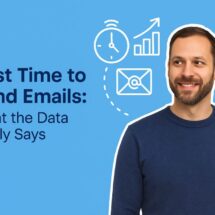
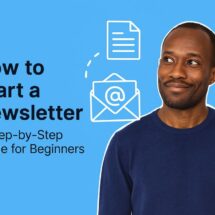
Trent Matthews
7/22/2024 12:03 pmYour positivity and enthusiasm are infectious It’s clear that you are truly passionate about what you do and it’s inspiring to see